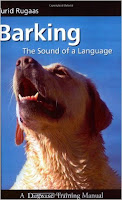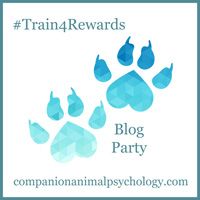Barking is a tough behaviour to address because barking is what we call a self-reinforcing behaviour: it often feels good for the dog to bark. Dogs bark for a variety of reasons: boredom, excitement, fear/alarm barking, to solicit attention, being protective or territorial, just to name a few. There are two approaches for dealing with this behaviour, and I recommend doing both: management and training an alternative behaviour.
Management Options:
- Don't leave the dogs outside unsupervised, let them out for a potty and then bring them back in. Take them for walks on leash and play indoor brain games for exercise and stimulation so they are not allowed to continue practicing this behaviour.
- Plant shrubs or flowers, add fencing, or add something along your fence line that somewhat obstructs your dogs' view of your neighbour to reduce the stimulation and trigger for this barking.
Training Options:
- Train an alternative behaviour for the specific triggers, such as seeing your neighbour. While inside the house, teach your dog the behaviour you want him to do instead of barking, such as “go to mat” or "touch" (target nose to hand) for example:
- Once your dogs have mastered the preferred behaviour in the house, go outside with some kibble or treats in your pocket along with your clicker if you use one. First practice the behaviour when no one else is around (for example, on a day off when most people are at work). Allow your dog to get very good at the behaviour under very low distraction first before practicing on a busy Saturday afternoon when the whole neighbourhood is out to tempt him to bark.
- When your dog notices something (turns head towards a sound, perks ears up, etc.), call them and ask for their preferred behaviour before they start barking. If this is not possible, don’t worry, still reward them once they perform the desired behaviour. After enough repetitions the dog will start to catch on and will more and more quickly offer the alternative behaviour.
- You can try any alternative behaviour you like: sit, down, mat, watch me (eye contact), or go get a toy. I like go get a toy, touch, or lay down the best because a dog is much less likely to bark when they are doing these behaviours.
- The downside to this is that you have to be outside with your dogs and on alert at all times during your training period (it can take about 5-6 weeks to break old habits), which is why it's a very good idea to utilize the management techniques listed above in combination with your behaviour modification so that you have fewer opportunities for your dogs to practice the undesired behaviour.
What to Avoid:
- Please don’t hit, scold, or otherwise punish your dog for barking. Barking is a completely natural dog behaviour and they don’t understand that neighbours may write letters and babies wake up from naps. They are just doing something that comes naturally to them. Not to mention, yelling and shouting may only amp the dog up further and make him believe you are joining in on the noise.
- Please, never ever use an anti-bark collar (especially a shock collar, but even a citronella collar). Dogs may bark because they are bored, afraid, stressed or excited. If a dog is bored or stressed is it fair or helpful to punish him? We chose to bring the dog into our home, so it is our responsibility to provide adequate exercise and mental enrichment to help the dog lead a full life.
- If the dog is stressed or fearful, punishment will only increase his stress and fear and could possibly cause further emotional or psychological issues.
- If the dog is excited, do we really want to punish happiness and zest for life out of our dog? No, we simply want them to be quiet, so let’s harness that energy and enthusiasm and redirect it to something more productive and fun.
Dogs don’t have spoken language as we do, so they use sounds and body language to communicate. Don’t ignore your dog’s communication, the better you understand your dog, the better (and less strained) your relationship will be.
Please see my Spring Fever and Boredom Busters blog posts for more helpful tips.
Keep in mind that dogs do bark and they will always bark, the idea here is to have them bark less. If you are having difficulty with complaints from a neighbour, consider writing them a friendly and apologetic note (maybe include a pair of ear plugs!) or have an in-person conversation and explain that you are working on the problem and appreciate their patience. If you continue to have difficulty after trying all of the above suggestions, you may want to seek out a professional trainer for assistance. Good luck!
Two books I would recommend for better understanding and managing barking are:

Barking, the Sound of a Language by Turid Rugaas
and

The Bark Stops Here by Terry Ryan
(Please price-check books before purchasing, as sometimes re-sellers mark up the prices)
To learn more about us, please visit our website at www.PawsitivePooch.ca
or
Visit us on Facebook at www.Facebook.com/PawsPetMB
About the Trainer:
Jillian is a Certified Professional Dog Trainer (CPDT-KA), meaning her knowledge on animal learning theory, husbandry, health, ethology, training equipment, and instructing skills have all been evaluated to the standard of the Certification Council for Professional Dog Trainers. This also includes adherence to a code of ethics and to the humane hierarchy for animal training.Jillian is a Fear-Free Certified Professional. To learn more about this certification, please visit http://www.vetfolio.com/fear-free-certification

This post was originally part of my contribution to the #Train4Rewards blog party, hosted by Zazie Todd, PhD, of Companion Animal Psychology. Due to popular demand, I have since expanded on this particular topic.
The Winnipeg Humane Society also has a blog post on the topic for further ideas and tips: http://www.winnipeghumanesociety.ca/pet-owners/yelp-line/barking/







